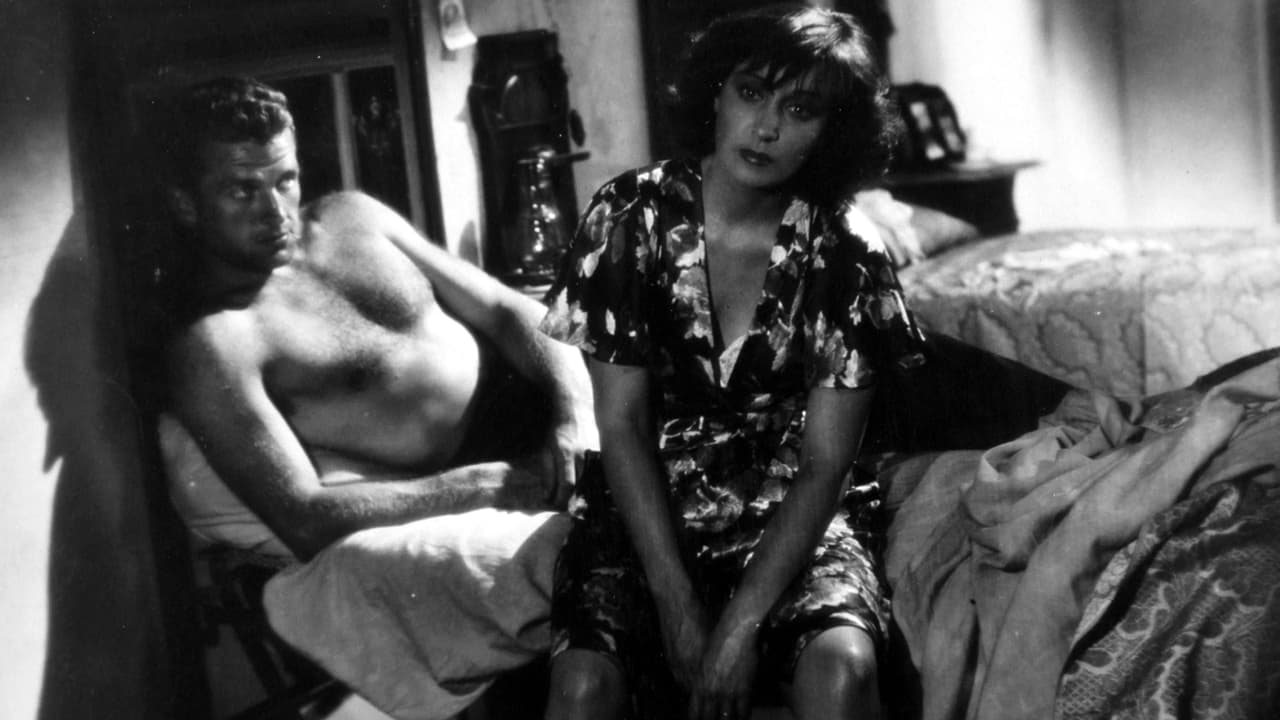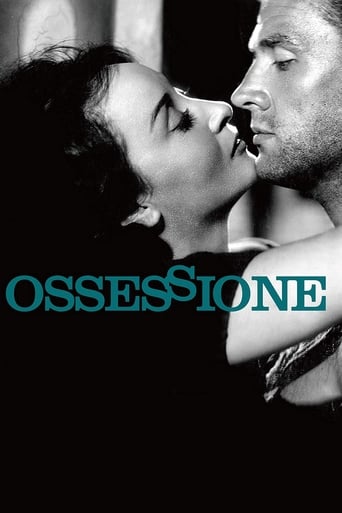

This Visconti film, based on an American pulp novel, is interesting largely due to the fact it is considered to be the first neo-realist piece. Indeed, Visconti well and truly transcends his dubious source material to create an innovative film that, to some degree, reflects the darkness, brutality and turmoil of Fascist Italy.Relying on minimal lighting, a small cast and a large amount of location shooting, a sense of realism is conveyed though, at times, this clashes with the melodrama of the sordid narrative. Also, at times, there is a threat that Visconti will veer into film noir territory though, thankfully, he never quite does so.The acting is solid though the character of the husband, a fat capitalist, is more of a caricature than anything else.Unfortunately, pacing problems ultimately undermine the story and any tension that may be building in the narrative dissipates due to the slow tempo.The bleak scenery of poverty-stricken rural towns and dock sides reflects the moral squalor of the characters and perhaps shows how one feeds on the other, with economic downturns leading to a break-up of the social fabric.Nevertheless, the brutally ironic conclusion reinforces the theme of the transience of life and how suddenly violent death can ensure.The music is suitably minimal and the acting is serviceable but ultimately the film lacks any kind of moral centre. Later neo-realism would rectify this shortcoming in the character of the young son in the Bicycle Thieves and the eponymous hero of Umberto D. but here Visconti presents a totally amoral world with only the largely characterless police representing a distant authority that can enforce any order. Perhaps rightly given the political circumstances under which the film was made, they are a remote, almost mechanical presence.Ultimately this is a strong film but one that is almost fatally undermined by its slow pacing. Still, most people will gain something of interest from it provided they do not expect a masterpiece of anywhere near the same calibre as the Bicycle Thieves.
... View MoreOssessione is in very bad state but is now undergoing a full restoration at Digital Film Lab in Copenhagen. The material used is a "Master positive" 2nd generation originally from the print Visconti managed to hide from the fascists. It has been scanned on the Spirit 4K (as 2K RGB data) then processed using DaVinci Revival restoration software. After this the rest is manual labor and we do not anticipate finishing before early spring. Sometime next year it should be available on DVD and hopefully also released on HD DVD. This film is beautiful and we hope the restoration effort will be enjoyed by many generations to come.
... View MoreThis movie is a ripoff of James Cain's novel, THE POSTMAN ALWAYS RINGS TWICE. Apparently, the director and producer never bothered to pay for rights to this story--perhaps the fact that we were in the middle of fighting the Italians in WWII might account for their forgetting to consider royalties! Despite this, the movie isn't really just an Italian version of the Hollywood movie. In some ways it's a lot better and in other ways, it is definitely not.The three central characters in this movie are really pretty ugly people. In fact, the male and female lovers are a bit icky-looking. The male lead is pretty ordinary except for his profuse body hair (particularly on the back and shoulders) and his lady love is, to put it frankly, unattractive. They are a very, very far cry from Lana Turner and John Garfield in the Hollywood version. And the ill-fated husband is really, really obese and loves to walk around shirtless--and his counterpart in the American film, Cecil Kellaway is definitely better looking (and probably better looking than the other two Italian leads, actually). And this unattractiveness is generally a reason I actually preferred the Italian film--since I just could NOT imagine a finely coiffed "dish" like Lana Turner in the middle of nowhere married to Kellaway--I am 100% sure she would have had dozens of better offers! Whereas, the Italian wife frankly might NOT have been able to do much better and this made the marriage actually believable.Part of the Italian film's believability comes from the blunt way it handles sex. The sanitized American film tries to make you believe that although Turner and Garfield kill Kellaway, they never actually get around to sex! This is pretty silly and totally unrealistic. In addition to the casual sexuality of the film, it's also pretty casual in showing the seamy side of life--with lots of sweaty people, a fly strip hanging over the kitchen table and everyone appeared to need a bath.The movie is also pretty fast-paced compared to the over-long American film. And what you get due to brevity isn't all good. The film lacks a lot of the style and polish of the American film--with grainier footage, relatively poor orchestration and sets. It sure ain't a pretty film, but the Neo-Realistic-like style makes the film seem more realistic. But it cannot make up for the short-cuts in the plot. Many of the plot elements in the later American version are either missing entirely or glossed over. And the ending seems a lot less interesting than the American film--and misses the entire human nature dilemma when Turner and Garfield turn on each other like rats (the best part of the American film).So which is the better film? Well, a lot of this probably depends on you. As for me, the Warner Brothers film was simply too polished and too unrealistic (though many like this style and may dislike watching films with subtitles)--but it packed a great ending. And the Italian film was much, much more realistic--until the crappy ending that seemed too rushed. So neither film is exactly great, but I'd give my nod to the Italian one being a bit better. It's too bad they couldn't have combined the best elements of both films into one exceptional film.
... View MoreLuchino Visconti was light years ahead of his contemporaries. The great directors of Italy of the 40s and 50s were men who understood the medium, but it was Luchino Visconti, a man of vision, who dared to bring a film like to show what he was capable of doing. He clearly shows his genius early on in his distinguished career with "Ossessione", a film based on James Cain's "The Postman Always Ring Twice", which was later made by Hollywood, but that version pales in comparison with what Visconti achieved in the movie. Luchino Visconti and his collaborators on the screen included an uncredited Alberto Moravia, a man who knew about the effect of passion on human beings.The film has been well preserved in the DVD format we watched recently. The film is a must for all serious movie fans because we can see how Visconti's vision translated the text into a movie that rings true in a plausible way, something the American version lacked.What comes across watching the movie, is the intensity which the director got from his key players. The magnificent Clara Calamai does an amazing job as Giovanna, the woman who has married an older man, but when Gino appears in her life, all she wants to do is rid herself of the kind man who gave her an opportunity in life. Giovanna is one of the best creations in Ms. Calamai's achievements in the Italian cinema. The last sequence of the film shows Ms. Calamai at her best in the ironic twist that serves as the moral redemption for the monstrous crime that was committed.Equally excellent is Massimo Girotti, one of the best actors of his generation who appears as Gino, the hunky man that awakens the obsessive passion in Giovanna. Gino is the perfect man for Giovanna, something that Mr. Girotti projects with such ease and sophistication not equaled before in the screen. Mr. Girotti makes the man come alive in a performance that seems so easy, yet with another actor it might not have been so apparent. Juan DeLanda is seen as Giuseppe, the older man who fell in love with Giovanna. In fact, his character rings truer than his counterpart in the American film, where he is seen more as a buffoon.The film is beautifully photographed by Domenic Scala and Aldo Tonti. They gave the film a naturalistic look that was the way Italian directors of the era favored. The original musical score of Giuseppe Rosati is perfect. Visconti, a man who loved opera and was one of the best directors, also includes arias by Bizet and Verdi that fit well in the context of the movie."Ossessione" is a film to treasure because we see a great Luchino Visconti at the top of his form.
... View More